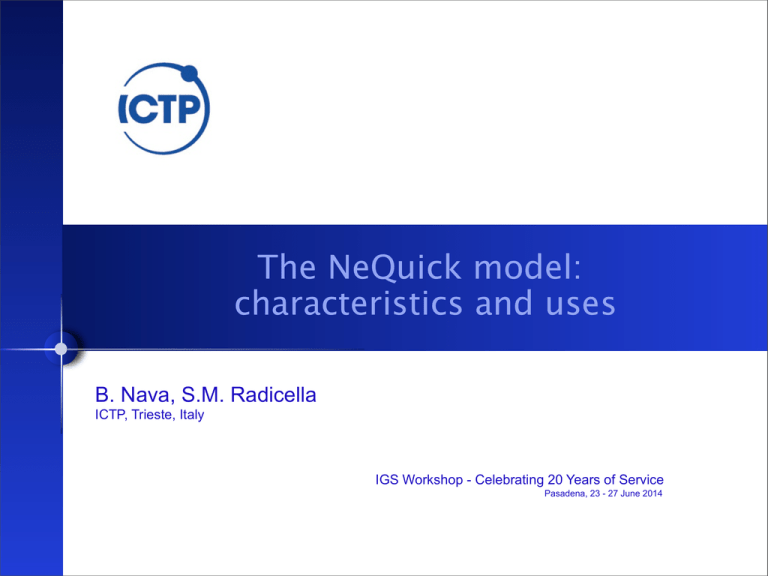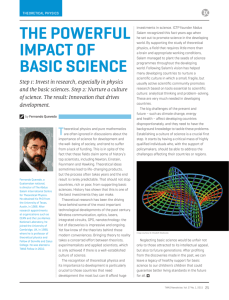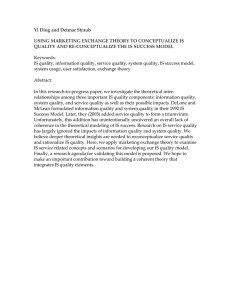The NeQuick model: characteristics and uses
advertisement

The NeQuick model: characteristics and uses B. Nava, S.M. Radicella ICTP, Trieste, Italy IGS Workshop - Celebrating 20 Years of Service Pasadena, 23 - 27 June 2014 Outline • NeQuick model • • NeQuick uses • • General description Assessment studies Data assimilation into NeQuick • • Use of effective parameters Least Square Estimation The abdus salam international centre for theoretical physics NeQuick model • The NeQuick is an ionospheric electron density model developed at the former Aeronomy and Radiopropagation Laboratory of The Abdus Salam International Centre for Theoretical Physics (ICTP), Trieste, Italy, and at the Institute for Geophysics, Astrophysics and Meteorology (IGAM) of the University of Graz, Austria. • It is based on the DGR ‘‘profiler’’ proposed by Di Giovanni and Radicella [1990] and subsequently modified by Radicella and Zhang [1995] and is a quick run model particularly tailored for transionospheric propagation applications. The abdus salam international centre for theoretical physics NeQuick 2 • Further improvements have been implemented by Radicella and Leitinger [2001]. • A modified bottomside has been introduced by Leitinger, Zhang, and Radicella [2005]. • A modified topside has been proposed by Coïsson, Radicella, Leitinger and Nava [2006]. • All these efforts, directed toward the developments of a new version of the model, have led to the implementation of the NeQuick2. B. Nava, P. Coïsson, S. M. Radicella, "A new version of the NeQuick ionosphere electron density model", Journal of Atmospheric and SolarTerrestrial Physics (2008), doi:10.1016/j.jastp.2008.01.015 The abdus salam international centre for theoretical physics NeQuick 2 online http://t-ict4d.ictp.it/nequick2 The abdus salam international centre for theoretical physics NeQuick 2 • The model profile formulation includes 6 semi-Epstein layers with modeled thickness parameters and is based on anchor points defined by foE, foF1, foF2 and M(3000)F2 values. • These values can be modeled (e.g. ITU-R coefficients for foF2, M(3000)F2) or experimentally derived. • NeQuick inputs are: position, time and solar flux; the output is the electron concentration at the given location and time. • NeQuick package includes routines to evaluate the electron density along any “ground-to-satellite” ray-path and the corresponding Total Electron Content (TEC) by numerical integration. The abdus salam international centre for theoretical physics NeQuick uses • • The NeQuick (v1) has been adopted by Recommendation ITU-R P. 531 as a procedure for estimating TEC. NeQuick 2 is the one currently recommended by ITU. • IRI model has adopted, as default option, NeQuick 2 model topside considered as: “the most mature of the different proposals for the IRI topside” (Bilitza and Reinisch (2008)). • A specific version of NeQuick has been adopted as Galileo Single-Frequency Ionospheric Correction algorithm and its the performance have been recently confirmed during In-Orbit Validation (Roberto Prieto-Cerdeira et al.; GPS World, June 2014). The abdus salam international centre for theoretical physics NeQuick for assessment studies Use of an ionospheric 3D electron density model to evaluate the impact of specific algorithms/assumptions in ionosphere-related parameters retrieval (e.g. in Satellite Navigation Systems). In particular NeQuick was used to: • generate “worst case” ionospheric scenarios for assessment and tuning of the operational ionospheric algorithms of EGNOS. The abdus salam international centre for theoretical physics NeQuick for assessment studies • investigate and characterize the “mapping function errors” in slant-to-vertical TEC conversion and vice-versa: • at range delay domain & at position domain Single ray-path error definition The abdus salam international centre for theoretical physics NeQuick for assessment studies Mapping function errors at position domain for different levels of solar activity in a low latitude station: Franceville (-2˚ N, 14˚ E). The abdus salam international centre for theoretical physics NeQuick for assessment studies • to investigate the effects of spherical symmetry assumption for the ionosphere electron density in Radio Occultation data inversion (e.g. using the “Onion Peeling” algorithm); TEC N1 rk Nk N3 dk,l rl The abdus salam international centre for theoretical physics rl-1 NeQuick for assessment studies Simulation results hmF2 & foF2 errors statistics for HSA period Co-location criteria for true profile and Onion Peeling derived profile exact matching The abdus salam international centre for theoretical physics NeQuick for assessment studies • to validate specific TEC calibration techniques • • using model derived slant TEC directly (e.g. with bias = 0) using model derived slant TEC to produce RINEX files (to be implemented; also including other effects; e.g. troposphere); The abdus salam international centre for theoretical physics Data ingestion into NeQuick • Empirical models like NeQuick have been conceived to reproduce the median behavior of the ionosphere (“climate”). • For research purposes and practical applications, to provide the 3-D electron density of the ionosphere for current conditions (“weather”), different retrieval techniques have been implemented. • They are based on the use of (multiple) effective parameters to adapt the NeQuick to GNSS‐derived TEC data (and ionosonde measured peak parameters values). The adaptation can be performed using TEC values from: • • • a single GNSS receiver multiple receivers maps The abdus salam international centre for theoretical physics Adapt NeQuick to IGS vTEC map grid points: lat.=-90°, 90° step 2.5° lon.=-180°, 180° step 5° The abdus salam international centre for theoretical physics Reconstruct foF2 map grid points: lat.=-90°, 90° step 2.5° lon.=-180°, 180° step 5° The abdus salam international centre for theoretical physics NeQuick2: validation results (effective param) Apr. 2000 foF2 error statistics Nava, B., S. M. Radicella, and F. Azpilicueta (2011), Data ingestion into NeQuick 2, Radio Sci., 46, RS0D17, doi: 10.1029/2010RS004635 The abdus salam international centre for theoretical physics Least Square Estimation Recently, to improve the NeQuick performance in retrieving the 3D electron density of the Ionosphere, a minimum variance leastsquares estimation (BLUE) has also been utilized to assimilate ground and space-based TEC data into NeQuick 2 (background). xa = xb + K (y - Hxb) K = BHT(HBHT + R)-1 A = (I-KH)B K is called gain of the analysis In our case: y = TEC xa = retrieved electron density xb = background electron density H -> “crossing lengths” in “voxels” R, B, A covariance matrix of observation, background and analysis error The abdus salam international centre for theoretical physics LS solution: a challenging case TUCU projections of the LEO -> GPS links below the LEO orbit tangent points of the LEO -> GPS links The abdus salam international centre for theoretical physics Results: retrieved electron density Cross section 23:30UT; -65.5ºE from -40ºN to -2ºN TUCU TUCU Background model (before the assimilation) Analysis (after the assimilation) The abdus salam international centre for theoretical physics Method validation Electron density profiles at JRO location Electron density profiles at Ionosonde location The abdus salam international centre for theoretical physics Conclusions • In the recent years, the NeQuick model in all its versions has demonstrated its validity in several kinds of applications. • In terms of assessment studies, it has indicated that a “synthetic” ionosphere can be used to evaluate the effects of specific algorithms/ assumptions in ionospheric parameters retrieval (e.g. in Satellite Navigation Systems). • In terms of scientific applications, the NeQuick model by mean of data ingestion and assimilation techniques, can be used to provide realistic “weather-like” descriptions of the 3-D electron density of the ionosphere. The abdus salam international centre for theoretical physics Thank you for your attention The abdus salam international centre for theoretical physics The abdus salam international centre for theoretical physics





